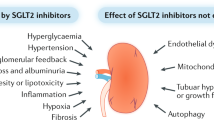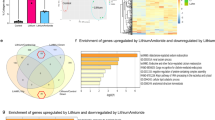Abstract
Lithium is widely used to treat bipolar disorder. Nephrogenic diabetes insipidus (NDI) is the most common adverse effect of lithium and occurs in up to 40% of patients. Renal lithium toxicity is characterized by increased water and sodium diuresis, which can result in mild dehydration, hyperchloremic metabolic acidosis and renal tubular acidosis. The concentrating defect and natriuretic effect develop within weeks of lithium initiation. After years of lithium exposure, full-blown nephropathy can develop, which is characterized by decreased glomerular filtration rate and chronic kidney disease. Here, we review the clinical and experimental evidence that the principal cell of the collecting duct is the primary target for the nephrotoxic effects of lithium, and that these effects are characterized by dysregulation of aquaporin 2. This dysregulation is believed to occur as a result of the accumulation of cytotoxic concentrations of lithium, which enters via the epithelial sodium channel (ENaC) on the apical membrane and leads to the inhibition of signaling pathways that involve glycogen synthase kinase type 3β. Experimental and clinical evidence demonstrates the efficacy of the ENaC inhibitor amiloride for the treatment of lithium-induced NDI; however, whether this agent can prevent the long-term adverse effects of lithium is not yet known.
Key Points
-
Nephrogenic diabetes insipidus (NDI) is a very common adverse effect of lithium therapy in psychiatric patients
-
Chronic kidney disease is a frequent and serious adverse effect of long-term lithium exposure
-
The principal cells of the collecting duct are the primary target for the cytotoxic effects of lithium, which are thought to involve inhibition of signaling pathways that involve glycogen synthase kinase type 3β
-
The epithelial sodium channel (ENaC) is the primary site of entry for lithium into the collecting duct; therefore, blockade of the ENaC by amiloride might prevent the nephrotoxic effects of lithium
-
Amiloride should be considered the treatment of choice for lithium-induced NDI and should be investigated for the prevention of lithium-induced nephropathy
This is a preview of subscription content, access via your institution
Access options
Subscribe to this journal
Receive 12 print issues and online access
$209.00 per year
only $17.42 per issue
Buy this article
- Purchase on Springer Link
- Instant access to full article PDF
Prices may be subject to local taxes which are calculated during checkout


Similar content being viewed by others
References
Belmaker, R. H. Bipolar disorder. N. Engl. J. Med. 351, 476–486 (2004).
Muller-Oerlinghausen, B., Berghofer, A. & Bauer, M. Bipolar disorder. Lancet 359, 241–247 (2002).
Freeman, M. P. & Freeman, S. A. Lithium: clinical considerations in internal medicine. Am. J. Med. 119, 478–481 (2006).
Fornai, F. et al. Lithium delays progression of amyotrophic lateral sclerosis. Proc. Natl Acad. Sci. USA 105, 2052–2057 (2008).
Martinez, A. & Perez, D. I. GSK-3 inhibitors: a ray of hope for the treatment of Alzheimer's disease? J. Alzheimers Dis. 15, 181–191 (2008).
Boton, R., Gaviria, M. & Batlle, D. C. Prevalence, pathogenesis, and treatment of renal dysfunction associated with chronic lithium therapy. Am. J. Kidney Dis. 10, 329–345 (1987).
Bendz, H., Sjodin, I. & Aurell, M. Renal function on and off lithium in patients treated with lithium for 15 years or more. A controlled, prospective lithium-withdrawal study. Nephrol. Dial. Transplant. 11, 457–460 (1996).
Presne, C. et al. Lithium-induced nephropathy: rate of progression and prognostic factors. Kidney Int. 64, 585–592 (2003).
Stone, K. A. Lithium-induced nephrogenic diabetes insipidus. J. Am. Board Fam. Pract. 12, 43–47 (1999).
Marples, D., Christensen, S., Christensen, E. I., Ottosen, P. D. & Nielsen, S. Lithium-induced downregulation of aquaporin-2 water channel expression in rat kidney medulla. J. Clin. Invest. 95, 1838–1845 (1995).
Laursen, U. H. et al. Changes of rat kidney AQP2 and Na, K-ATPase mRNA expression in lithium-induced nephrogenic diabetes insipidus. Nephron Exp. Nephrol. 97, e1–e16 (2004).
Kim, Y. H. et al. Altered expression of renal acid–base transporters in rats with lithium-induced NDI. Am. J. Physiol. Renal Physiol. 285, F1244–F1257 (2003).
Christensen, B. M. et al. Changes in cellular composition of kidney collecting duct cells in rats with lithium-induced NDI. Am. J. Physiol. Cell Physiol. 286, C952–C964 (2004).
Christensen, B. M., Kim, Y. H., Kwon, T. H. & Nielsen, S. Lithium treatment induces a marked proliferation of primarily principal cells in rat kidney inner medullary collecting duct. Am. J. Physiol. Renal Physiol. 291, F39–F48 (2006).
Nielsen, J. et al. Segment-specific ENaC downregulation in kidney of rats with lithium-induced NDI. Am. J. Physiol. Renal Physiol. 285, F1198–F1209 (2003).
Nielsen, J., Kwon, T. H., Frokiaer, J., Knepper, M. A. & Nielsen, S. Lithium-induced NDI in rats is associated with loss of α-ENaC regulation by aldosterone in CCD. Am. J. Physiol. Renal Physiol. 290, F1222–F1233 (2006).
Rojek, A. et al. Altered expression of selected genes in kidney of rats with lithium-induced NDI. Am. J. Physiol. Renal Physiol. 288, F1276–F1289 (2005).
Rao, R. et al. Lithium treatment inhibits renal GSK-3 activity and promotes cyclooxygenase 2-dependent polyuria. Am. J. Physiol. Renal Physiol. 288, F642–F649 (2005).
Kotnik, P. et al. Altered expression of COX-1, COX-2, and mPGES in rats with nephrogenic and central diabetes insipidus. Am. J. Physiol. Renal Physiol. 288, F1053–F1068 (2005).
Li, Y., Shaw, S., Kamsteeg, E. J., Vandewalle, A. & Deen, P. M. Development of lithium-induced nephrogenic diabetes insipidus is dissociated from adenylyl cyclase activity. J. Am. Soc. Nephrol. 17, 1063–1072 (2006).
Bichet, D. G. Lithium, cyclic AMP signaling, A-kinase anchoring proteins, and aquaporin-2. J. Am. Soc. Nephrol. 17, 920–922 (2006).
Nielsen, J. et al. Proteomic analysis of lithium-induced nephrogenic diabetes insipidus: mechanisms for aquaporin 2 down-regulation and cellular proliferation. Proc. Natl Acad. Sci. USA 105, 3634–3639 (2008).
Cohen, P. & Frame, S. The renaissance of GSK3. Nat. Rev. Mol. Cell Biol. 2, 769–776 (2001).
Gould, T. D. & Manji, H. K. Glycogen synthase kinase-3: a putative molecular target for lithium mimetic drugs. Neuropsychopharmacology 30, 1223–1237 (2005).
O'Brien, W. T. et al. Glycogen synthase kinase-3β haploinsufficiency mimics the behavioral and molecular effects of lithium. J. Neurosci. 24, 6791–6798 (2004).
Christensen, B. M., Loffing, J., Hummler, E. & Rossier, B. C. Collecting duct-specific gene inactivation of α ENaC protects mice against lithium-induced nephrogenic diabetes insipidus. J. Am. Soc. Nephrol. 17, 295A (2006).
Bedford, J. J. et al. Amiloride restores renal medullary osmolytes in lithium-induced nephrogenic diabetes insipidus. Am. J. Physiol. Renal Physiol. 294, F812–F820 (2008).
Bedford, J. J. et al. Lithium-induced nephrogenic diabetes insipidus: renal effects of amiloride. Clin. J. Am. Soc. Nephrol. 3, 1324–1331 (2008).
Batlle, D. C., von Riotte, A. B., Gaviria, M. & Grupp, M. Amelioration of polyuria by amiloride in patients receiving long-term lithium therapy. N. Engl. J. Med. 312, 408–414 (1985).
Leverich, G. S. et al. The poor prognosis of childhood-onset bipolar disorder. J. Pediatr. 150, 485–490 (2007).
Bendz, H., Aurell, M., Balldin, J., Mathe, A. A. & Sjodin, I. Kidney damage in long-term lithium patients: a cross-sectional study of patients with 15 years or more on lithium. Nephrol. Dial. Transplant. 9, 1250–1254 (1994).
Bendz, H., Andersch, S. & Aurell, M. Kidney function in an unselected lithium population. A cross-sectional study. Acta Psychiatr. Scand. 68, 325–334 (1983).
Lepkifker, E. et al. Renal insufficiency in long-term lithium treatment. J. Clin. Psychiatry 65, 850–856 (2004).
Bassilios, N. et al. Monitoring of glomerular filtration rate in lithium-treated outpatients—an ambulatory laboratory database surveillance. Nephrol. Dial. Transplant. 23, 562–565 (2008).
Hestbech, J., Hansen, H. E., Amdisen, A. & Olsen, S. Chronic renal lesions following long-term treatment with lithium. Kidney Int. 12, 205–213 (1977).
Markowitz, G. S. et al. Lithium nephrotoxicity: a progressive combined glomerular and tubulointerstitial nephropathy. J. Am. Soc. Nephrol. 11, 1439–1448 (2000).
Farres, M. T. et al. Chronic lithium nephropathy: MR imaging for diagnosis. Radiology 229, 570–574 (2003).
Thoma, C. R., Frew, I. J. & Krek, W. The VHL tumor suppressor: riding tandem with GSK3β in primary cilium maintenance. Cell Cycle 6, 1809–1813 (2007).
Quiroz, J. A., Gould, T. D. & Manji, H. K. Molecular effects of lithium. Mol. Interv. 4, 259–272 (2004).
Alexander, M. P., Farag, Y. M., Mittal, B. V., Rennke, H. G. & Singh, A. K. Lithium toxicity: a double-edged sword. Kidney Int. 73, 233–237 (2008).
Bauer, M. Review: lithium reduces relapse rates in people with bipolar disorder. Evid. Based Ment. Health 7, 72 (2004).
Gonzalez-Pinto, A., Aldama, A., Mosquera, F. & Gonzalez Gomez, C. Epidemiology, diagnosis and management of mixed mania. CNS Drugs 21, 611–626 (2007).
Garfinkel, P. E., Ezrin, C. & Stancer, H. C. Hypothyroidism and hyperparathyroidism associated with lithium. Lancet 2, 331–332 (1973).
Christiansen, C., Baastrup, P. C., Lindgreen, P. & Transbol, I. Endocrine effects of lithium: II. 'Primary' hyperparathyroidism. Acta Endocrinol. (Copenh.) 88, 528–534 (1978).
Bendz, H., Sjodin, I., Toss, G. & Berglund, K. Hyperparathyroidism and long-term lithium therapy—a cross-sectional study and the effect of lithium withdrawal. J. Intern. Med. 240, 357–365 (1996).
Hundley, J. C., Woodrum, D. T., Saunders, B. D., Doherty, G. M. & Gauger, P. G. Revisiting lithium-associated hyperparathyroidism in the era of intraoperative parathyroid hormone monitoring. Surgery 138, 1027–1031 (2005).
Sloand, J. A. & Shelly, M. A. Normalization of lithium-induced hypercalcemia and hyperparathyroidism with cinacalcet hydrochloride. Am. J. Kidney Dis. 48, 832–837 (2006).
Gregoor, P. S. & de Jong, G. M. Lithium hypercalcemia, hyperparathyroidism, and cinacalcet. Kidney Int. 71, 470 (2007).
Sajid-Crockett, S., Singer, F. R. & Hershman, J. M. Cinacalcet for the treatment of primary hyperparathyroidism. Metabolism 57, 517–521 (2008).
Shiraki, T., Kohno, K., Saito, D., Takayama, H. & Fujimoto, A. Complete atrioventricular block secondary to lithium therapy. Circ. J. 72, 847–849 (2008).
Darbar, D., Yang, T., Churchwell, K., Wilde, A. A. & Roden, D. M. Unmasking of Brugada syndrome by lithium. Circulation 112, 1527–1531 (2005).
Acknowledgements
Désirée Lie, University of California, Irvine, CA, is the author of and is solely responsible for the content of the learning objectives, questions and answers of the Medscape-accredited continuing medical education activity associated with this article.
Author information
Authors and Affiliations
Corresponding author
Ethics declarations
Competing interests
The authors declare no competing financial interests.
Rights and permissions
About this article
Cite this article
Grünfeld, JP., Rossier, B. Lithium nephrotoxicity revisited. Nat Rev Nephrol 5, 270–276 (2009). https://doi.org/10.1038/nrneph.2009.43
Issue Date:
DOI: https://doi.org/10.1038/nrneph.2009.43
This article is cited by
-
Lithium: how low can you go?
International Journal of Bipolar Disorders (2024)
-
Lithium poisoning and renal replacement therapy: pathophysiology and current clinical recommendations
International Urology and Nephrology (2023)
-
Lithium-induced nephropathy; One medication with multiple side effects: a case report
BMC Nephrology (2022)
-
The ubiquitin ligase NEDD4-2/NEDD4L regulates both sodium homeostasis and fibrotic signaling to prevent end-stage renal disease
Cell Death & Disease (2021)
-
Association between nocturia and frailty among elderly males in a veterans administration population
Aging Clinical and Experimental Research (2020)



